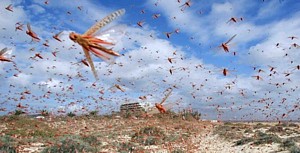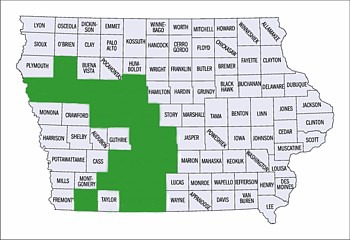|
AN INVASION of GRASHOPPERS
 It was in August of this year [1867] that myriads of grasshoppers first appeared in western Iowa. They seemed to
come from the region of the Rocky Mountains where they breed in vast numbers. When large enough to fly, they rise in
the air to a great height usually moving in a northeasterly direction. They seem to know in what direction they wish
to emigrate and when on the wing, if overtaken by adverse winds, frequently settle to the earth and alight until the
wind changes or subsides. While on the ground they feed ravenously upon tender vegetation, devouring growing crops
and garden vegetables. In 1867 they were traced from the mountain regions west of Kansas, alighting in that State at
various points and doing serious damage to growing crops. Moving in a northeasterly direction they crossed the
Missouri River and invaded the western counties of Iowa. Their ravages were most severe in the counties of Woodbury,
Ida, Sac, Calhoun, Page, Adams, Ringgold, Clarke, Adair, Warren, Polk, Madison, Cherokee, Carroll, Greene, Dallas,
Boone and Webster.

Small grain was harvested before their appearance and escaped damage while corn and vegetables were freely devoured
by the millions which literally shadowed the sun like a cloud, as the pursued their onward flight. On a bright day
they first attracted the attention of persons looking toward the sun, when they had the appearance of snow flakes,
their gauzy wings glistening in the sunlight at a great height above the earth. When wishing to feed they slowly
settled to the earth until the ground was covered with a moving swarm of the insects, devouring every green, growing
thing within the line of their march. They often remained for weeks in the same region, at night crawling up corn
stalks, large weeds, fences and the sides of buildings and when daylight appeared, descending again to the ground to
feed. In some localities they remained until November, depositing millions of eggs just beneath the surface before
they resumed their travels in the air. After completing their stay, suddenly, as though a signal had been given,
they would, after months of living on the ground, slowly rise with glistening white wings to a great altitude and
disappear. The damage done by the pests was not great as most farm crops were well matured before their advent to
the earth. The first swarms which came later and remained several weeks, hatched the next summer and from these
great damage was done before their wings grew large enough to enable them to fly. While they remained their
appetites were unlimited and as they hopped and crawled along, every green plant on their line of march was wholly
or partially devoured. They spread out over most of western Iowa but were much more numerous in some localities than
in others. Crops were only partially destroyed but the aggregate damage was very great in more than forty counties.
Early in June the wings of the earliest hatched had become large enough to enable them to start on their travels and
by the last of the month nearly all had disappeared.
SOURCE: GUE, Benjamin F. History of Iowa: From the Earliest Times to the
Beginning of the Twentieth Century. Vol. 3, Chapt. 2. 1903.


|


